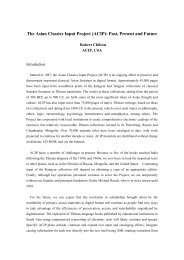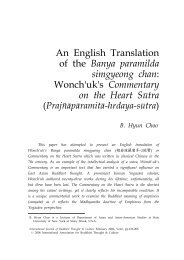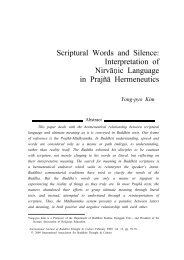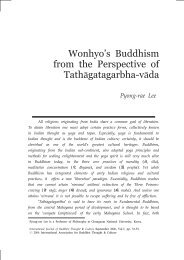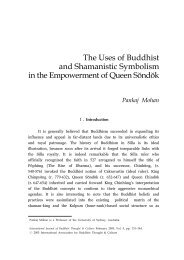Esoteric Buddhism under the KoryÅ in the Light of ... - Buddhism.org
Esoteric Buddhism under the KoryÅ in the Light of ... - Buddhism.org
Esoteric Buddhism under the KoryÅ in the Light of ... - Buddhism.org
Create successful ePaper yourself
Turn your PDF publications into a flip-book with our unique Google optimized e-Paper software.
International Journal <strong>of</strong> Buddhist Thought & Culture 57<br />
died out <strong>in</strong> Korea. 1 In fact this is <strong>in</strong> l<strong>in</strong>e with <strong>the</strong> general neglect <strong>of</strong><br />
studies on <strong>Esoteric</strong> <strong>Buddhism</strong> <strong>in</strong> Ch<strong>in</strong>a - and beyond a handful <strong>of</strong><br />
studies, we still need to <strong>under</strong>stand <strong>the</strong> nature <strong>of</strong> <strong>the</strong> great amount <strong>of</strong><br />
primary material available, not to f<strong>org</strong>et <strong>the</strong> related elements <strong>of</strong> material<br />
culture, i.e. images, monuments and ritual paraphernalia, and to look <strong>in</strong><br />
closer detail on <strong>the</strong>ir impact on <strong>the</strong> Korean Buddhist tradition <strong>of</strong> <strong>the</strong><br />
Koryŏ arguably <strong>the</strong> period <strong>in</strong> Korean history where <strong>Esoteric</strong> <strong>Buddhism</strong><br />
had its “Golden Age.”<br />
For <strong>the</strong> sake <strong>of</strong> mak<strong>in</strong>g my arguments easier to follow, allow me<br />
first give a brief def<strong>in</strong>ition <strong>of</strong> <strong>the</strong> phenomena I def<strong>in</strong>e as <strong>Esoteric</strong><br />
<strong>Buddhism</strong>. <strong>Esoteric</strong> <strong>Buddhism</strong> is a development <strong>of</strong> traditional Mah2y2na,<br />
<strong>in</strong> fact a development which had begun long before <strong>the</strong> dist<strong>in</strong>ctively<br />
philosophical and devotional schools <strong>of</strong> that tradition had become<br />
established around <strong>the</strong> 3-4th centuries CE. 2 The signall<strong>in</strong>g features <strong>of</strong><br />
<strong>Esoteric</strong> <strong>Buddhism</strong> is belief <strong>in</strong> magic forces which are effectuated<br />
through spells or dh2ra!is. In <strong>the</strong> early phase <strong>the</strong> dh2ra!i are found as a<br />
sort <strong>of</strong> appendix to a s^tra. Eventually hand-gestures (Skr. m^dra) were<br />
added to <strong>the</strong> spells, and later sanctified, ritual spheres symboliz<strong>in</strong>g <strong>the</strong><br />
spiritual world (Skr. ma!dala) <strong>of</strong> <strong>the</strong> <strong>in</strong>voked div<strong>in</strong>ity (or div<strong>in</strong>ities) came<br />
about. As <strong>the</strong> tradition wore on <strong>the</strong>se basic features became <strong>in</strong>creas<strong>in</strong>gly<br />
complex and sophisticated eventually giv<strong>in</strong>g way to whole systems <strong>of</strong><br />
ritualized cosmology which signals <strong>the</strong> mature form <strong>of</strong> <strong>Esoteric</strong><br />
<strong>Buddhism</strong>.<br />
In certa<strong>in</strong> contexts <strong>the</strong> <strong>Esoteric</strong> Buddhist tradition will be seen as<br />
be<strong>in</strong>g directly based on traditional Mah2y2na beliefs and doctr<strong>in</strong>es, <strong>in</strong><br />
o<strong>the</strong>r cases this philosophical/doctr<strong>in</strong>al foundation is not particularly<br />
evident, and one is better served by accept<strong>in</strong>g that certa<strong>in</strong> traditional<br />
1 The two <strong>Esoteric</strong> Buddhist schools <strong>in</strong> modern Korea, i.e. <strong>the</strong> Ch<strong>in</strong>ŏn 眞 言 and <strong>the</strong> Ch<strong>in</strong>’gak 眞<br />
覺 , have absolutely no historical l<strong>in</strong>k with <strong>the</strong> Korean Buddhist tradition per se but are late<br />
constructs based <strong>in</strong> large measures on Japanese Sh<strong>in</strong>gon <strong>Buddhism</strong>. This is also borne out <strong>in</strong><br />
<strong>the</strong> classical Sh<strong>in</strong>gon iconography which dom<strong>in</strong>ates <strong>the</strong>ir temples. For a <strong>in</strong>formation on <strong>the</strong>se<br />
schools, see Yi (1986). Rudimentary <strong>in</strong>formation can also be found <strong>in</strong> Mok (1983).<br />
2 Traces <strong>of</strong> <strong>Esoteric</strong> Buddhist beliefs crop up <strong>in</strong> a variety <strong>of</strong> Indian Buddhist scriptures, mostly <strong>of</strong><br />
Mah2y2na persuasion, as early as <strong>the</strong> beg<strong>in</strong>n<strong>in</strong>g <strong>of</strong> <strong>the</strong> Christian Era. See fx. <strong>the</strong><br />
Saddharma-pu!3ar6ka, <strong>the</strong> Lank2vat2ra, <strong>the</strong> Ga!3avy^ha etc.



